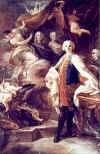|
CENTRO STUDI FARINELLI |
 |
Forensic
experts and music historians investigate
the life and death of the celebrated singer...
New
Findings on Farinelli, the Famed Castrato
By
Carlo Vitali
MusicalAmerica.com
November 14, 2007
BOLOGNA -- - On Oct. 28, 15 months after the disenterment of Farinelli’s
remains from Bologna’s main cemetery La Certosa [Researchers
Discuss Findings in Farinelli's Grave], a mid-term report about the findings was
delivered by Maria Giovanna Belcastro, professor of physical anthropology at the
University of Bologna, during a conference held at the city’s Accademia
Filarmonica, of which Farinelli was a member. The session was chaired by Patrick
Barbier, a French academic who has written various essays on castrati and serves
as president of the (Bologna-based) Centro Studi Farinelli, which launched the
project.
Although historic/archeological forensic investigation is hardly new, the
initial disinterment on July 12, 2006, generated major international media
attention. It also raised doubts among unenlightened readers and bloggers,
mostly in the vein of “waste of public money” and “disrespectful of the
dead.”
In delivering her report, professor Belcastro addressed such criticism, pointing
out that the project’s cost was financed by private funds (mostly from
Florentine antiquarian-cum-publisher Alberto Bruschi), and that forensic
scientists worldwide hold respect for the deceased as a matter of policy. After
the study, she explained, Farinelli’s remains will find their way back into
the original grave, not on some museum shelf.
According to the elegant Latin memorial on the tombstone, two corpses were laid
in the subterranean vault: the legendary male soprano Carlo Broschi, nicknamed
Farinelli (1705-1782), and his grand-niece Maria Carlotta Tadolini, born
Pisani-Broschi (1769-1850). Farinelli was put to rest there in 1810, after
Napoleon’s cemetery laws called for old burials to be relocated from churches
to suburban grounds. At the disinterment, two human skeletons were indeed found:
a female and a male, both deceased at a considerable age.
The latter was laid on the west end of the pit, in poorer condition, heaped up
apparently in order to make place for the new entry. From his head, only
fragments of the lower jaw -- with its molars still in place -- and parts of the
skullcap were found. Elsewhere scientists discovered fragments of a shoulder
blade, a clavicle, an ulna (the long bone in the forearm), a rib, one lumbar
vertebra and both femurs (long bones in the thigh).
The woman has been described as short and frail, with evidence of hip
malformation, while the man is uncommonly tall and sturdy, features consistent
with the singer’s portraits and contemporary descriptions, including one
self-labeling as “il lungo Farinelli” [the tall F]. “That would be a
typical outcome of castration,” explained Belcastro. “As growth is
controlled by the competing action of two hormones, HGH and testosterone, a lack
in the latter may easily cause the bones to increase to an abnormal length.”
An extremely tight ischiatic notch (connecting the head of the femur to the
pelvis) provides one more hint to castration, as does frontal hyperostosis (abnormal
thickening of the frontal bone), until now the only discovered trace of any
major pathology. An enlarged jaw and a fairly normal set of teeth have also been
measured. In fact, the old man’s dental condition was excellent. At the time
of death, he still had 25 teeth out of 32 and his molars showed only scant
wear-and-tear -- probably indicating conscientious oral healthcare.
Unfortunately, no trace is left of the large silk cloak (a regalia of the
Spanish knightly order of Calatrava) in which Farinelli’s corpse was to have
been wrapped, according to his will of 1778; that notwithstanding, there is
little reasonable doubt as to the identity of the remains. Study of other
elements is ongoing and in-depth examination of pathologic indicators is to be
pursued next year at the Pisa University by professor Gino Fornaciari, renowned
for his earlier investigations on the Medici and Aragon ruling dynasties (in
Florence and Naples, respectively) as well as on the naturally mummified corpse
of composer and virtuoso cellist Luigi Boccherini, buried in Lucca, Tuscany. A
detailed medical history of Farinelli the patient, based on diaries, letters and
sundry period sources, is available in print, published just weeks into the
Centro’s proceedings.*
[(*) Eva Rizzuti et al., “Anamnesi versus autopsia?” in: Il Farinelli e gli evirati cantori (L. Verdi, ed.), Lucca : LIM, 2007, at pp. 279-298.]
